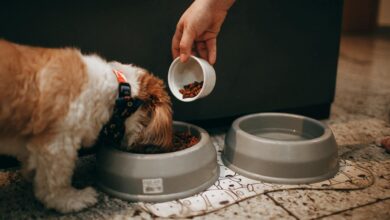
Bringing a brand new pet into your property is a momentous event stuffed with pleasure and pleasure. Whether or not you are adopting a playful pet, a curious kitten, or a loving senior pet, you are opening your coronary heart and residential to a brand new member of the family. Alongside this pleasure comes the duty of making certain their security and well-being. Simply as you’d child-proof your property for a toddler, pet-proofing your property is a vital step to guard your furry companions from potential hazards. On this complete information, we’ll discover pet-proofing ideas and methods to create a secure and pet-friendly surroundings in your four-legged relations.
Table of contents
Pet-Proofing Your House
The Significance of Pet-Proofing
Image this: you’ve got simply adopted an cute pet. With boundless power and curiosity, they discover each nook and cranny of your property. Identical to a baby, pets are naturally inquisitive, and so they depend on you to maintain them secure. That is the place pet-proofing turns into paramount.
Pet-Proofing serves a number of very important functions:
- Security: The first objective of pet-proofing is to maintain your pets secure by eliminating potential hazards and risks in your house. Simply as you’d baby-proof a room, you are now pet-proofing it.
- Well being: Many widespread home items and vegetation might be poisonous to pets. Pet-proofing helps forestall unintentional poisoning. For instance, that luscious poinsettia plant in your windowsill is likely to be stunning, nevertheless it’s poisonous to pets.
- Conduct: A pet-friendly surroundings can even affect your pet’s conduct positively. By eradicating potential stressors and risks, you cut back their nervousness and reduce harmful tendencies. Think about how relaxed your cat can be once they cannot knock over vases or chew on electrical cords.
- Peace of Thoughts: Figuring out that your house is secure in your pets permits you to take pleasure in their companionship with out fixed fear. You’ll be able to concentrate on cuddles and playtime as a substitute of fretting over what they may get into subsequent.
The Pet-Proofing Course of
Now that we perceive why pet-proofing is crucial, let’s discover the method.
- Evaluation: Start by assessing your residence out of your pet’s perspective. Get right down to their eye stage and search for hazards or tempting objects. Think about you are a playful kitten or a curious pet. What would catch your consideration? This angle shift is enlightening.
- Identification: Subsequent, determine potential risks. Search for poisonous vegetation, choking hazards like small objects, electrical cords which may resemble chew toys, or sharp objects that would hurt your pet.
- Elimination: As soon as you’ve got recognized hazards, take steps to eradicate or safe them. Rearrange furnishings to dam entry to harmful areas, use security gates to limit sure rooms, and relocate poisonous substances to excessive cabinets or cupboards with childproof locks. Bear in mind, pets are artful, so take further precautions.
- Coaching: Alongside bodily pet-proofing, contemplate coaching your pets. For instance, educate your canine to keep away from particular areas or objects, just like the cat’s litter field. Reward-based coaching can work wonders in reinforcing secure behaviors.
- Supervision: Whereas pet-proofing is crucial, no plan is foolproof. All the time supervise your pets, particularly once they’re exploring new areas of your property. Vigilance is vital to their security.
Pet-Proofing Your Kitchen
Hazards within the Kitchen
The kitchen is usually a bustling hub of exercise in any residence, and it is important to make sure it is secure in your pets.
Listed here are some kitchen hazards for pets:
- Poisonous Meals: Many human meals are poisonous to pets. Chocolate, onions, grapes, and sure sweeteners might be lethal. Preserve them out of attain or locked in cupboards.
- Sizzling Surfaces: Pets are naturally curious and may not perceive {that a} sizzling range burner can burn them. Use range knob covers and create obstacles to forestall entry.
- Trash Bins: Canine, particularly, are drawn to trash. It is a treasure trove of attention-grabbing scents and discarded meals. Use a secured trash can with a lid that your pets cannot simply open.
- Chemical substances: Cleansing merchandise and chemical compounds underneath the sink might be hazardous. Use cupboard locks and retailer these things out of attain.
Pet-Pleasant Kitchen Suggestions
To pet-proof your kitchen successfully, observe the following tips:
- Safe Trash: Spend money on a pet-proof trash can with a lid that your pets cannot simply open, making certain that tempting smells keep out of attain.
- Lock Cupboards: Use childproof cupboard locks to maintain cleansing provides and probably dangerous objects inaccessible to your pets.
- Pet-Secure Vegetation: If in case you have indoor vegetation, guarantee they’re non-toxic to pets. Widespread poisonous vegetation embody lilies, philodendrons, and poinsettias. Go for pet-safe options.
- Countertop Deterrents: Use pet deterrents like motion-activated sprays to discourage pets from leaping onto counter tops. Over time, they’re going to be taught to remain off.
Pet-Proofing Your Toilet
Toilet Hazards
Bogs can harbor a number of risks for pets, from poisonous substances to small objects that may be ingested.
Listed here are some toilet hazards for pets:
- Poisonous Chemical substances: Cleansing merchandise, medicines, and private care objects like lotions and soaps might be poisonous if ingested. Preserve them out of attain and use cupboard locks.
- Rest room Bowl Water: Canine, particularly, could also be tempted to drink from the bathroom. Nonetheless, bathroom bowl water can comprise dangerous micro organism or cleansing chemical compounds.
- Small Objects: Cats, particularly, might bat round small objects like hair ties or dental floss, which might be ingested and result in choking or blockages.
- Slippery Flooring: Pets can battle to take care of their footing on moist toilet tiles. This could result in accidents, particularly in older pets with mobility points.
Pet-Pleasant Toilet Suggestions
To pet-proof your toilet successfully, contemplate these precautions:
- Lock Cupboards: Use childproof locks on toilet cupboards to safe cleansing merchandise and medicines, making certain that your pets cannot entry these probably harmful objects.
- Rest room Security: Think about using a bathroom lock to forestall pets from consuming from the bowl. That is particularly essential in the event you use automated bathroom bowl cleaners.
- Take away Small Objects: Preserve small objects like hair ties, cotton swabs, and dental floss off counter tops and flooring the place pets can entry them. Retailer these things securely in drawers or cupboards.
- Non-Slip Mats: Place non-slip mats or rugs within the toilet to assist your pets keep their footing, particularly when you’ve got tile or hardwood flooring.
Pet-Proofing Your Yard
Outside Hazards
Your yard must be a secure house in your pets to play and discover, however it may possibly harbor potential risks.
Listed here are some outside hazards for pets:
- Poisonous Vegetation: Sure outside vegetation might be poisonous to pets, together with azaleas, oleander, and foxglove. Ingesting these vegetation can result in critical well being points.
- Fencing: Make sure that your fence is safe, with no gaps or areas the place your pets can escape. Commonly examine it for injury.
- Pesticides and Fertilizers: Chemical remedies in your garden or backyard might be dangerous if ingested. Go for non-toxic garden and backyard care merchandise to maintain your pets secure.
- Water Options: Swimming pools, ponds, and even buckets of water can pose a drowning danger for pets, particularly if they can not simply climb out.
Pet-Pleasant Yard Suggestions
To pet-proof your yard successfully, observe the following tips:
- Plant Choice: Select pet-safe vegetation in your backyard and take away any poisonous ones. Seek the advice of a listing of pet-friendly vegetation for steerage.
- Safe Fencing: Commonly examine your fence for injury or areas the place pets may escape. Contemplate putting in a sturdy fence in the event you do not have already got one.
- Non-Poisonous Garden Care: Go for non-toxic garden and backyard care merchandise. There are many eco-friendly choices out there that will not hurt your pets.
- Supervision: All the time supervise your pets once they’re outdoors, particularly close to water options. Even when your pet is a good swimmer, accidents can occur.
Pet-Proofing Your House
In conclusion, pet-proofing your property and yard is a vital step in offering a secure surroundings in your beloved pets. Whether or not you will have a curious kitten, an adventurous pet, or a sensible senior pet, these precautions will assist you create a safe haven the place your furry mates can thrive. Keep in mind that every pet is exclusive, so be attentive to their conduct and wishes, and regulate your pet-proofing efforts accordingly. Your pets will thanks with years of affection and companionship in a safe and nurturing surroundings.








